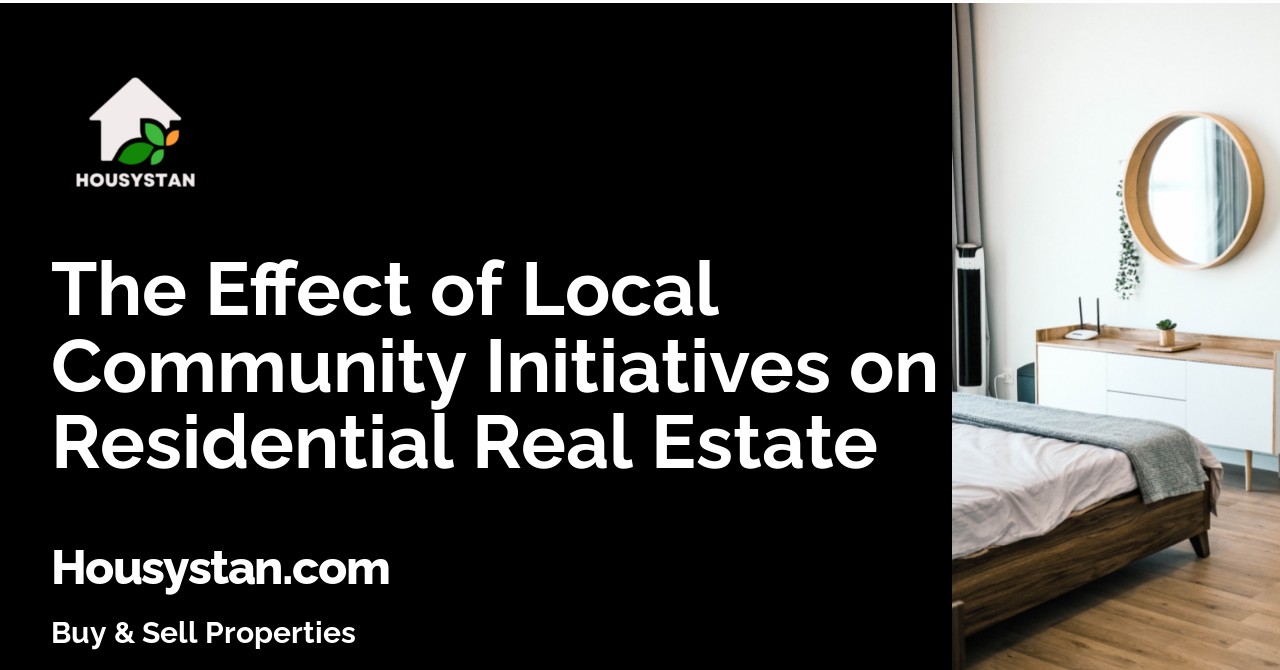The Effect of Local Community Initiatives on Residential Real Estate
Read latest blogs and articles from Housystan

The Information mentioned here was last updated on:
11/12/2025The Power of Local Community Initiatives on Residential Real Estate
In recent years, local community initiatives have been transforming neighborhoods across the globe, leaving a notable impact on residential real estate. These grassroots movements often focus on improving public spaces, fostering sustainability, and enhancing social cohesion, all of which can significantly influence property values and demand.
The Vision Behind Community Initiatives
- Verified Tenants/Buyers
- Unlimited Property Listing
- Zero subscription/charges fee
Local community initiatives are efforts led by residents, local organizations, or partnerships between residents and municipal authorities. They aim to address specific local needs and improve quality of life for neighborhood residents. By fostering a sense of community and pride, they often create a ripple effect that enhances the aesthetic and functional appeal of a neighborhood.
Key areas often targeted by these initiatives include:
- Urban Greening: This involves planting trees, developing community gardens, and enhancing parks. Green spaces not only improve air quality but also boost the visual appeal of an area, making it more attractive to buyers.
- Public Art Projects: Murals, sculptures, and other art installations add character to neighborhoods and make them more vibrant and attractive. They can also drive foot traffic and tourism, benefiting local businesses.
- Sustainability Practices: Initiatives aimed at reducing carbon footprints, such as community solar projects or local recycling campaigns, can enhance a neighborhood's appeal to environmentally-conscious buyers.
The Economic Influence on Property Values
The relationship between local community initiatives and residential real estate values is noteworthy. These programs can lead to an increase in property values due to the enhanced desirability of the area.
Enhanced Livability
Improved public infrastructure and increased community engagement make neighborhoods more livable. Streets with well-maintained sidewalks, safe parks, and operational public amenities generally attract potential homebuyers. An area that emphasizes pedestrian-friendly environments and quality public spaces often sees an uptick in property values.
Demand and Supply Dynamics
As neighborhoods become more desirable due to successful community initiatives, demand for homes in these areas often rises, pushing property prices upward. This is especially true in urban settings where buyers prioritize proximity to amenities and vibrant community life.
Cash Inflows
Increased real estate values often lead to higher property tax revenues, which can be reinvested into further community improvements. This cyclical benefit can sustain and grow neighborhood initiatives, contributing even more to long-term real estate value enhancement.
Boosting Social Cohesion and Community Participation
Community initiatives don't just bolster real estate values; they also weave a stronger social fabric, leading to more engaged and active residents. Such engagement can manifest as volunteer efforts, local business support, and an increase in public gatherings, all of which contribute to a safer and more welcoming environment.
Increased Safety
Communities that are closely knit usually experience lower crime rates. As neighbors get to know one another and work together on projects, they create networks of trust that deter criminal activity, adding an extra layer of appeal for prospective homebuyers.
Local Business Thriving
Energetic communities often support local businesses, which thrive as a result. When small businesses flourish, neighborhoods benefit from increased economic activity, job creation, and greater convenience for residents, further boosting the attractiveness of the area.
Real Estate Trends: What Buyers Are Looking For
Today's homebuyers are increasingly aware of the quality of neighborhoods and the community spirit that exists within them. Many prioritize long-term livability over short-term gains. This shift in buyer priority has driven real estate trends toward neighborhood reputation and communal identity.
Proximity Matters
Accessibility to public transport, schools, and community centers continue to be prime considerations for buyers. However, the presence of community initiatives and their positive outcomes also play a crucial role in influencing buying decisions. Buyers are more inclined to choose areas where they see a potential for growth and improvement facilitated by collective community efforts.
Emphasizing Green Spaces
With rising awareness of climate change, many buyers value environmentally focused initiatives. A neighborhood's focus on sustainability can significantly affect its appeal, drawing in the environmentally-conscious demographic.
Case Studies of Successful Community Initiatives
Real-world examples provide some of the most compelling evidence of the impact of community initiatives on real estate. Let’s look at some successful endeavors that have transformed neighborhoods and bolstered their real estate markets.
Example 1: The High Line, New York City
Originally a disused railway track, the High Line was transformed into a sprawling elevated park in New York City. This community-driven project revitalized the surrounding neighborhoods, drawing tourists and boosting local real estate values significantly. Properties adjacent to the High Line have seen increased values and heightened demand due to this green transformation.
Example 2: The Millennium Park, Chicago
Once a derelict rail yard, the Millennium Park is now an iconic civic center in Chicago. Community and government efforts to develop this park not only uplifted the local infrastructure but also spurred a real estate boom in the adjacent downtown Chicago area. It's a prime example of how targeted initiatives can reinvigorate a local economy and elevate real estate prospects.
Conclusion
As more communities adopt proactive approaches to enhance their neighborhoods, the intersection between community initiatives and real estate becomes increasingly relevant. These movements have demonstrated their power to not only increase property values but also foster a sense of belonging and stimulate local economies. Moving forward, the partnership between communities and real estate markets is poised to grow stronger, underscoring the vital role that community-driven initiatives play in shaping attractive, sustainable neighborhoods.